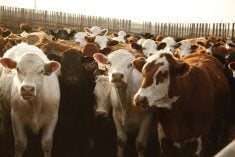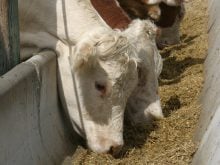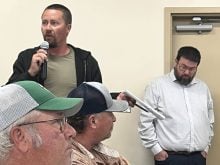Matching the right livestock to the right area and managing them in the right way can do a lot for local ecology. On the exposed limestone mountains of Ireland’s Burren region, a unique and ancient cattle production system provides an example of how livestock can save and build biodiverse landscapes.
Farmers in the Burren employ a system called winterage, where cattle graze the windswept, rain-soaked mountains of west County Clare from autumn until spring. The cattle are brought back to the valleys and farmsteads for the rest of the year, before once again moving to their mountain winter pastures (called winterages by locals) as the days shorten and temperatures cool.
It’s a counterintuitive system compared to the more common practice of grazing upland pastures in summer, but it’s been practised by Burren farmers for thousands of years, and is critical to preserving the vast array of flora and fauna for which the Burren is famous.
In recent decades, however, the winterage system was under threat from economic pressures and misdirected government production policy.
The efforts of dedicated farmers and environmental researchers helped save the system while improving farm profitability. As new challenges from government policies emerge, the Burren’s farm and research communities are once again gearing up to preserve their millennia-old method.
Aoife Forde, an agricultural adviser and cattle farmer from the region, provided a local perspective on the unique features of a production style linked to the Burren’s environmental and cultural heritage.
Over a cup of tea in her family’s kitchen, Forde detailed how she and her family raise their “suckler cow herd” — cow-calf in Canadian parlance — and the physical qualities of the landscape that make it work.
The first humans arrived in Ireland’s Burren region tens of thousands of years ago — as much as 33,000 years ago, according to some estimates. Current evidence suggests people were farming in the area about 6,000 years ago. The practice of wintering cattle on the mountains is estimated to be thousands of years old, something that stone-age herdspeople adopted after observing how environmental conditions affected the area’s unique landscape.
That landscape varies considerably, with lowland areas dominated by blends of hazel woods, scrubland and other small to mid-sized trees, as well as grasses and pastures. The uplands appear little more than bare and weather-worn limestone from a distance, but closer inspection reveals a diverse, thick mat of plant life growing from rich, albeit thin and patchy soil. The region’s climate typifies many parts of Ireland, featuring an abundance of rain and a moderate temperature throughout the year. Precipitation in winter is heavy.
Each characteristic — exposed limestone surfaces, rich plant life in between, and heavy winter rainfall — makes the uplands ideal for winter grazing.
The limestone mountains absorb solar energy in warmer parts of the year, then slowly release it through winter. This provides cattle with warmth and, as Forde describes, “a dry lie” in otherwise wet conditions. Even on chilly spring days, touching the limestone reveals a surprising amount of warmth.
The diversity of plant species makes for good grazing, and with relatively low stocking densities, upland pastures last well beyond the herd’s winter stay. Winter rain also brings abundant, accessible water to mountains, which have dried out in summer.
“I went to college in Waterford (for) agricultural science. I remember the first time I told my friends that we put our cows out to the mountain for the winter. They didn’t believe me. They thought ‘this lady is off her head.’ I hadn’t realized it was such a unique system,” says Forde.
“It gives them a dry lie, plenty of water, obviously, and loads of forage…The winterages are extremely sheltered, so if the weather is bad, the cows will just tuck themselves up in a spot. They’re very, very hardy. They will survive. I think sometimes people don’t give cattle enough recognition for how intelligent they are.”
The biodiversity of the Burren’s mountain ecosystems is a result of grazing cattle over winter. As general grazers, browsing cattle keep hazel and other thick scrub from out-competing and smothering other plant species. The result is a colourful, biodiverse environment that flowers each spring and summer, working in both contrast and conjunction with hazel environs in lowland areas.
“There are plenty of hazel woodlands in the Burren,” says Forde, reiterating hazel and other scrub form important habitats themselves. “But anywhere the dense hazel grows, you won’t see any flowers because they physically don’t have the light. We could say ‘OK, we’re going to take all those animals off the landscape, and we’re going to let it revert back.’ And that would be fine. You’d lose all the rock because it would disappear under the hazel, and you’d lose all the flora.
“The Burren is very unique because you get the Arctic flora and the Mediterranean flora growing beside each other.”
The closing decades of the 20th century brought significant changes to the Burren, with governments encouraging farmers to streamline production, while placing grazing restrictions on mountain ecosystems now deemed an important biosphere.
In place of their traditional and more labour-intensive winterage practices, cattle were moved to barns and sheds over winter, relying on silage rather than mountain greenery. This was a more expensive, but also more efficient, way to raise cattle. The change was also more conducive to holding an off-farm job — something that is now the norm.
As the years passed, thick scrub encroached further and further up the mountainsides, choking out the Burren’s diverse and rare plant species.
Staying profitable was also an increasing challenge. As the consequences of this production shift grew, farmers and environmental researchers developed a plan to reintroduce sustainable farming practices on the mountain.
This began by measuring the impact of grazing, or lack thereof, on the Burren’s upland areas. Forde credits one particular researcher, Brendan Dunford, as a main driving force behind efforts to produce policy change.

Together, Dunford, research colleagues and the wider Burren community developed a sustainable farming blueprint for the region — the BurrenLIFE project. Based on this blueprint, and with government funding, 2010 saw the establishment of the Burren Program — a compensation system where farmers are paid based on the health of their winterage pastures. The ancient practice made a significant comeback as farmers extended winter grazing, targeted supplementary feeding, repaired and maintained stone field boundaries and water sources and controlled invasive species.
A charity was also established. Called the Burrenbeo trust, the initiative’s goal is to support wider community interest in the region’s landscape while inspiring further conservation efforts. Through the charity, farmers and researchers connect with the public, school groups and others through a variety of events.
The Burren winterage programs are a success. They supported the re-establishment of an ancient, sustainable farming system and provided an example for other agriculture-adjacent conservation efforts.
But now, the Irish government is changing its Common Agricultural Policy. Under the new policy framework, Aoife says the Irish Department of Agriculture removed many of the core elements established by BurrenLIFE.
Payments will be made based on the environmental assessment of an entire farm, for example, not for well-maintained or expanded winterages.
“There has been some magnificent research done by the BurrenLIFE team. They literally have figures year on year that show the flora numbers are increasing, the scores are increasing, so we’ll have to wait and see what happens next,” Forde says. “Everyone knows (the Burren program). It’s European wide, it’s basically global at this stage, that it is the footprint for results-based payments.”















